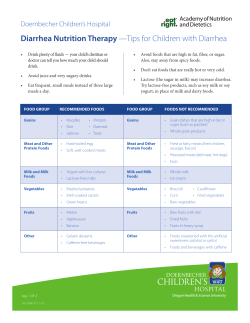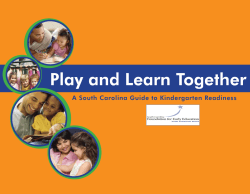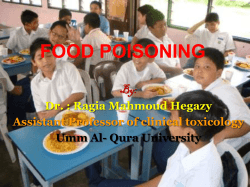
Treating Your Child's Vomiting or Diarrhea
Vomiting and diarrhea 1 Treating Your Child's Vomiting or Diarrhea Description/Cause/ Expected Course The main goal of treatment is to prevent dehydration. Your child needs to drink enough fluids to replace the fluids lost from vomiting or diarrhea. Even with the correct diet, vomiting or diarrhea may continue. Oral rehydration therapy is a way to help your child when he or she has vomiting or diarrhea. This therapy has 3 simple rules: Rule 1. Give your child a special liquid called an oral electrolyte solution to prevent serious dehydration. An oral electrolyte solution is a liquid that has exactly the right amount of water, sugar, and salts. You can buy this solution in most drugstores in different forms such as liquid (Pedialyte), or special popsicles. School‐aged children may also drink sports drinks such as Gatorade but it is best to avoid the red flavors. Rule 2. Feed your child healthy, good foods to help him or her heal. Rule 3. Know how to decide when your child is not getting better. Rule 1. Give your child an oral electrolyte solution. As soon as your child starts vomiting or having diarrhea, give your child oral electrolyte solution. For the first 6 hours make sure your child gets at least the right amount for his or her age. Age Amount Less than 6 months old 2 to 3 ounces every hour If you are breastfeeding, do not stop. Feed your child for a shorter time and more often. Breast milk is the best liquid for your child. 6 months to 2 years old 3 to 4 ounces every hour If you are breastfeeding, do not stop. Feed your child for a shorter time and more often. Breast milk is the best liquid for your child. 2 years or older 4 to 8 ounces every hour Hints: 1. If your child is vomiting, use a teaspoon or syringe to give regular sips of liquid. Give your child 5 mL of liquid, which is 1 teaspoon, every 1 to 5 minutes 2. Do not let your child take a large drink, even if he or she is very thirsty. Large drinks may make vomiting worse. 3. When your child starts to feel better, you can give larger drinks, but less often. Make sure that your child keeps getting at least the amount of liquid he or she needs for his or her age. 4. After 1 day, or 24 hours, give your child the oral electrolyte solution only after each watery diarrhea. 5. Do not give your child liquids that have lots of sugar, such as apple juice, Kool‐Aid, and soft drinks. Sugar will make your child's diarrhea worse. 6. Always start by giving regular small sips of the oral electrolyte solution. This will help your child get used to the salty taste of this drink, which is likely new. This will take time. If absolutely necessary you may add a small amount of Kool Aid powder to flavor plain electrolyte solution. Rule 2. Feed your child healthy, good foods to help him or her heal. Feeding your child healthy, good food, milk, or formula will help fight your child's infection. It will also help to heal his or her stomach and intestines and prevent loss of weight. ONLY if your child is vomiting, stop giving him or her food, milk, and formula for 6 to 12 hours. But do not stop breastfeeding. Breast milk is the best food for your child. If your child has diarrhea, do not stop feeding your child. Every 3 to 4 hours, give your child Vomiting and diarrhea 2 small amounts of food that your child likes. Starchy foods such as bread, cereals, pasta, and rice, and fresh fruits and vegetables are the best foods to give your child. Do not give foods that your child has never eaten just because they are on the list of good foods. Do not give foods that have lots of sugar or fat. Here is a list of the good foods that you should feed your child. Do not feed your child foods that are on the list of bad foods. Good Foods Do feed your child: breast milk, regular milk with no water added (if your child is over 1 year), or formula starchy foods, such as rice, potatoes, noodles, toast, and crackers cereals, such as rice or wheat cereal, and oatmeal protein, such as boiled or baked meat, fish, and chicken, and eggs vegetables with no added butter fruits not packed in syrup soup yogurt with live cultures, such as Stonyfield Farm or Dannon Bad Foods Do not feed your child grape juice, apple juice, orange juice, soft drinks, or ginger ale ice cream or sherbet sweetened cereals fatty foods such as french fries, hamburgers, and butter spicy foods Rule 3. KNOW HOW TO DECIDE WHEN YOUR CHILD IS NOT GETTING BETTER. Call your doctor if your child has any of the warning signs on this list: not willing to drink over 4 to 6 hours no tears when crying vomiting often for more than 4 to 6 hours sunken eyes more than 6 large, watery diarrheas in 1 day stomach pain that is severe and does not stop less than 4 wet diapers in 1 day fast breathing dry skin, mouth, and tongue very sleepy or very fussy cool or grayish skin severe head or neck pain green vomit blood in the vomit or diarrhea bringing the knees up to stomach and crying sunken fontanelle (the soft spot on your child's head if he or she is less than 18 months old). As always, please call the office with any questions or concerns! [This information has been adapted from information provided by The Hospital for Sick Children) © Copyright The Hospital For Sick Children 1998‐2001. All Rights Reserved © Copyright eCHN 1998‐2001. All Rights Reserved. Thursday Nov 15, 2001
© Copyright 2025





















